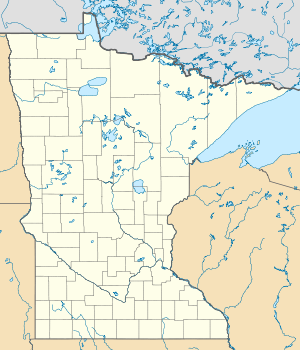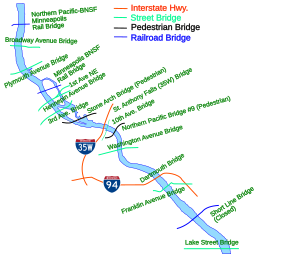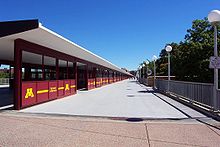Washington Avenue Bridge (Minneapolis)
Coordinates: 44 ° 58 ′ 24 ″ N , 93 ° 14 ′ 21 ″ W.
| Washington Avenue Bridge | ||
|---|---|---|
| Washington Avenue Bridge in Minneapolis (looking south from NP Bridge # 9 ) | ||
| use | Four lanes of County Road 122 on the lower deck, bicycles and pedestrians on the upper deck | |
| Crossing of | Mississippi River | |
| place | Minneapolis , Minnesota | |
| Entertained by | Minnesota Department of Transportation | |
| Building number | 9360 | |
| construction | Steel girder bridge | |
| overall length | 345 m | |
| Longest span | 76.5 m | |
| Clear height | 21 m | |
| start of building | 1962 | |
| completion | 1965 | |
| location | ||
|
|
||
| Bridges in Minneapolis / St. Paul | ||
| Washington Ave. Bridge is located midway between Northern Pacific Bridge # 9 and I-94 | ||
The Washington Avenue Bridge is a steel girder bridge in Minneapolis , Minnesota . It connects the two campus parts of the Twin Cities Campus of the University of Minnesota on the western and eastern banks of the Mississippi River .
The bridge is unique because of its two-story construction, with the lower level being reserved for road traffic and the upper deck for pedestrians and cyclists. It is a functional building with simple architecture , but it is of cultural importance because thousands of students , faculty employees and visitors use the bridge every day.
history
An iron truss bridge was first built in 1884; however, it was a little farther upstream, connecting parts of Washington Avenue on either side of the river. At the time of its construction, most of Minneapolis' residents lived in what is now known as Bohemian Flats . The bridge was extended in 1890 to the transport with trams to accommodate and the first line from Minneapolis to the neighboring Saint Paul led it. Tram traffic ceased in 1954 and the fate of the obsolete bridge was sealed after construction of the current bridge began in 1962. The demolition took place in 1965.
This first construction was a straight bridge from east to west, which led Washington Avenue over the Mississippi River into the center. The new building aims a little further south at the western end and no longer connects directly to Washington Avenue, but to a short freeway -like section on 3rd and 4th streets - both streets are one-way streets . The section of road between Interstate 35W to the west and University Avenue to the east, to which the bridge belongs, was originally part of Minnesota State Highway 122 , and in 1997 Hennepin County took over administration of the road from the Minnesota Department of Transportation . To get to Washington Avenue on the West Bank today, vehicles must take the first exit after the western bridgehead or turn north in the center.
The upper deck of the bridge was originally just a straight surface. The use in the harsh winter was very uncomfortable, so that in the 1970s a partial overbuilding of the pedestrian area was added. The original intention was to heat the interior, however, due to energy costs, the transition is essentially not heated. The few fan heaters in it warm up the pedestrian area only sparsely in winter, and the internal temperature can drop below freezing point. There are also wind deflectors on the structure for the open area, which provide a little shade in summer due to their overhangs.
At least Winston Close, who represented the university in the team of architects for the new bridge, had the Ponte Vecchio in Florence in mind for the upper deck . This plan, which included shops on the bridge, had it been implemented, would have made the bridge a place to linger rather than just crossing the river. Efforts are now being made to make the bridge a slightly more welcoming place. Since the closed construction of part of the upper level was added, a competition has been held annually after the summer holidays, in which the various associations at the university largely present themselves .
The external design of the bridge structure is mostly an olive combination with brown and gray . It is criticized that the building does not fit into the surroundings of the university, especially after the Weisman Art Museum, designed by Frank Gehry , was built next to the Ostend in the 1980s. In 1997, University President Mark Yudof initiated a campaign called “ Take Pride in U ” , which led to the upper level being repainted in the university's burgundy and gold colors . Later, in the first few years of the 21st century, the superstructure was also given a new coat of paint over the course of two years. The renovation gave the bridge a more appealing look. The long duration of the painting work was caused by the fact that the old paint contained white lead and was therefore carefully removed.
The various suicides cast a shadow over the history of the bridge . The poet and university professor John Berryman is the most famous of the suicides. He plunged himself into the depths in 1972. About half a dozen other people also killed themselves jumping off the bridge. Since various students said they heard the footsteps of non-existent pedestrians behind them and other such phenomena were also reported, the building acquired the reputation of being haunted by ghosts.
Light rail
The structure was rebuilt from 2011 to make it usable for the light rail. The Metro Green Line , which runs from Minneapolis to St. Paul, has been crossing the Mississippi River here since 2014 .
swell
- Peter Ritter (February 24, 1999). Water Under a Troubled Bridge. City Pages .
- Scott F. Anfinson: Archeology of the Central Minneapolis Riverfront . Volume 1: Historical Overview and Archaeological Potentials (= The Minnesota Archaeologist. Vol. 48, No. 1/2, 1989, ZDB -ID 2072781-1 ). Minnesota Archaeological Society, St. Paul MN 1989.
- Steve Riner Details of Routes 101-149. Minnesota Highways unofficial website.
- Erin Ghere (March 29, 1999). Bridge repainting project causes traffic concerns. ( Memento of May 6, 2003 on the Internet Archive ) The Minnesota Daily .
- Mary Charlotte Costello: Climbing the Mississippi River Bridge by Bridge. Volume 2: Minnesota. MC Costello, Davenport IA 2002, ISBN 0-9644518-2-4 .
|
Upstream Northern Pacific Bridge Number 9 |
Crossing the Mississippi River |
Downriver Dartmouth Bridge |





